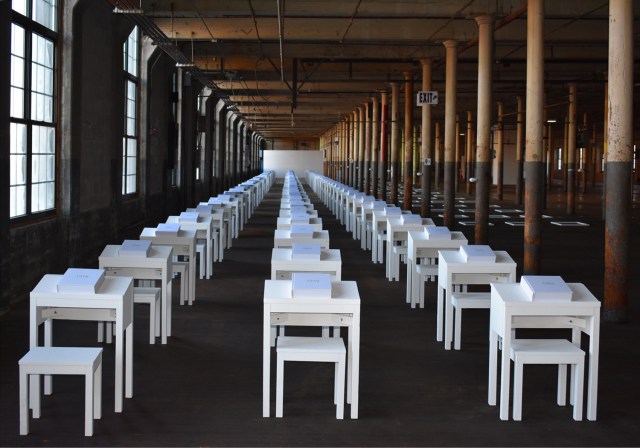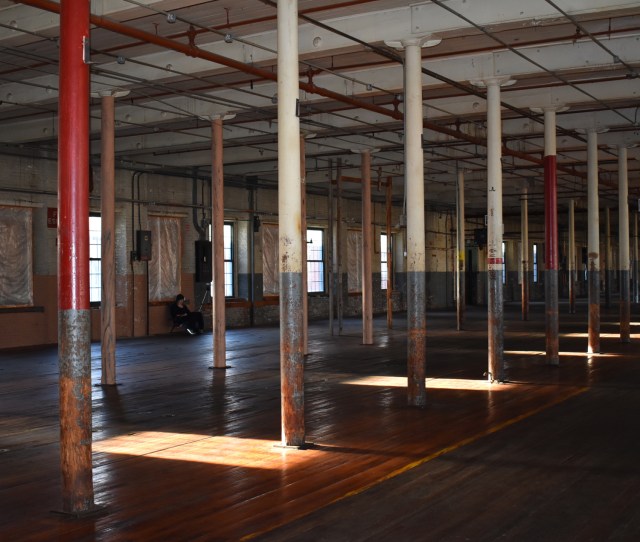
I spent last weekend on the Maine-Canada border, exploring forested land in Coburn Gore and trying to get my eyes on the “Slash.” The Slash is a literal cut through the forest that marks the divide between Canada and the United States. The International Boundary Commission tends the cut, which runs through 1349 miles of wooded land along the 5525 miles that make up the entire border between the two countries. It was an inspiring weekend which I’ll share more about in the future; in this post I want to describe the last stop on the journey: Amy Stacey Curtis’ 9th solo-biennial project, Memory, at the Bates Mill complex in Lewiston. When I arrived, I was exhausted from the weekend of border exploration, but I was determined to see the final installation in Curtis’ 18-year project. I’ve followed the solo-biennial work for years, and participated  (gathering and contributing soil for a previous biennial), but this was the first installation I was able to see in person.
(gathering and contributing soil for a previous biennial), but this was the first installation I was able to see in person.
The emotional impact of Curtis’ work sneaks up on you, given its analytical, ordered presence. Even the viewing process is controlled; the viewer is instructed on how to proceed step-by-step through the exhibition. These directions are one key to the installation’s success. I’ve often shared the film The Five Obstructions with my students. In the film, filmmakers Jorgan Leth and Lars von Trier are shown remaking Leth’s famous short film, The Perfect Human, 5 times with 5 sets of obstructions. The film provides an engaging example of how structure, with its implicit limitations, creates the space for creative work to take shape successfully. As I progressed through steps 1 – 9 in the Memory biennial, I noted the lean formal structure, but even more important, the control the artist exerted over my movements, as viewer. That control became an essential part of the content of the work.
There is no question, as the viewer takes a position in front of the video segment (step 2, as I recall), of how much time he or she will commit the video. The viewer’s interior question,”Will this be an exercise in dutiful patience or will it draw me in?” is replaced by simply following Amy’s directions and standing in front of the piece as instructed (until the voices in the video reach “100”). Amy’s instructions are unambiguous, and because the format is so clear, the viewer trusts the artist and stays put without the distraction of self consideration. The mind doesn’t bother with, “How does Lucinda view a video in an art installation?” (thinking of The Perfect Human: “Look, the perfect human moving in a room,” “How does she lie down? This is how she lies down, like this.”). Following Amy’s instructions feels necessary, as if the viewer will miss an opportunity if he/she disobeys.

Part way through the exhibit, after reading instructions asking me to make a certain number of marks in a huge slab of clay, my emotions caught me off guard. I pressed my fingers into the clay, and found it to be harder and fleshier than I anticipated. Amy has written about her work as a means of processing traumatic experiences she’s lived through,  and that knowledge—just as a context, without awareness of any specifics—caused me to feel my body in the space in a conscious way. And given the current wave of people outing their stories of abuse, as a way to speak truth to the dark misogyny of the Republican Presidential candidate, I found the simple act of pressing my finger into clay to be emotionally difficult. And from that mid-point in the exhibition, I entered some liminal state where the history of my own body moved through the space with me.
and that knowledge—just as a context, without awareness of any specifics—caused me to feel my body in the space in a conscious way. And given the current wave of people outing their stories of abuse, as a way to speak truth to the dark misogyny of the Republican Presidential candidate, I found the simple act of pressing my finger into clay to be emotionally difficult. And from that mid-point in the exhibition, I entered some liminal state where the history of my own body moved through the space with me.
The tears came as I entered a space filled with desks, each with a dated journal, where the viewer was asked to a pick plot point of memory, find the appropriate year/desk/book, and write that memory down. I sat down at 1972 and flipped to a blank page, skipping over others’ anonymous stories as I searched. I was surprised to catch: “The birth of my daughter–still an angel” and “The year I met the man of my dreams.” It wouldn’t have occurred to me to go to the brightest points of my life when asked to remember. Remembering the darker passages seemed to me to be the point, but of course, in that perception the work was showing me something about myself, as its participant.
In the 9th and final piece in the installation, I stepped though 9 frames, going through a process of intentional remembering in each one. As I moved to the final square, I stood within the frame determined to slow down in a memory of excessive pleasure. I stayed there for a few minutes, letting my body linger in that space.
As I moved toward the exit, I realized I was still trying to stuff my sadness. I found Amy closing up the space and realized that I was trying to squelch my emotions because I didn’t want to burden her, or the carefully articulated space, with messy feelings. At the same time, I was aware that my very sadness was true to my participation, to the work Curtis created, and it represented my shared authorship of the work, as viewer. As we chatted about the impact of the installation, Amy shared that the piece had inspired a lot of emotion and that more than a few of the viewings had ended in hugs and tears. Memory is so clean and clear a piece, the sentiment so stripped away, that what is left is a large, open space for an authentic response. The response depends on what the viewer brings into the room.
Memory closes on October 28th. Until then it’s open every day, noon-5:00. More Info



An amazingly wonderful post, Lucinda. Reminds us what art is “for” as well as that art really is only for itself. And how it affects us through that. Looking forward to future posts about the border “slash”.
Thanks, Judith. It’s been a long time since an exhibit made me cry!
I wish I could go do this! Maybe there’s a way to take a quick trip up from NYC before it closes. I love the idea of being guided this way through my own memories.
Lots of other reasons to come to Maine too!
Isles of Nine: The Sequel
For my second tour, I morph Eagle.
( I’d been scolded, become her most mad fool long before my first visit ended. Been scolded!)
From RedMons Aerie I soared southeast to Wetland Canopy.
Isle premiere: a botanist’s dream; hoary vegetating tangles of green-gold, lush with redblue,redgreen, redyellow jungle-flowered foliage.
Isle Deux: riverrun, mammalian haven. I dispatch baby hippo. Snap his spine, tear eyes from some squalling mother who runs panicked, shrieking, braying in ugly circles. I snap the spines of a redbrown fawn and red-splotched Guernsey calf; eat and drink my fill. A nap before heading to
Isle Tri: Meadows everywhere, more greengold, alfalfa-grazing cows, utter milk, cheese, yogurt and ice-cream abound. Hay bales fill the wan-bleu horizons. Bales.
Isle Quatro: Conceive forty-thousand acres of tools; of iron and steel and metal, basking in the hearth of a hard, near-blinding sun. I float in the updraft to
Isle Cinkle: The whirr of motors, of engines, things on wheels, endless motion moving roto-motions. Springs-spraing-sproingo.Echo echo.
Isle Sixto: So many balls, toys, games, red-blooded children, laughing. Small fry. Score?
Isle Sever: skyscrapers, bridges, wholly static racket fills me talons to tail feathers. All the way to
Isle O’Chaos: hand in hand people everywhere relate. ( love hush whisperers “I said ‘Open….to persuasion…more or less…not Love! you.’ )
Isle E-neuf: a shammamar, expanse of sands, surrounding seas churning, redolent with foam.
(If I die before I wake, etc. From this second time coming going return around crosswind fantasy tour…., )